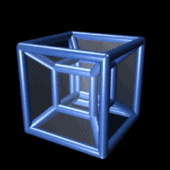4D


4D, meaning the common 4 dimensions, is a theoretical concept in mathematics. It has been studied by mathematicians and philosophers since the 18th century. Mathematicians who studied four-dimension space in the 19th century include Möbius, Schläfi, Bernhard Riemann, and Charles Howard Hinton.
In geometry, the fourth dimension is related to the other three dimensions of length, width, and depth by imagining another direction through space. Just as the dimension of depth can be added to a square to create a cube, a fourth dimension can be added to a cube to create a tesseract.
By analogy, the universe of a 2D (two dimensional) being is a plane, but this plane may curved into a sphere. This means that if a two dimensional object goes forever forward in a straight line, the object will end up in the same position it started from. So, applying this idea to three dimensions, we can say that our universe is curved into a fourth dimension. Thus, if a three dimensional object walks forever in a straight line, the object will end up in its starting point.
Going into theoretical physics, if we look with a large enough magnification into a point in our universe, it may be possible to see how the universe was (its size in light years) many years ago. As the observable universe now is 93 billion light years long and the Big Bang, theoretically, began approximately 14 billion years ago. Will it be possible to see how our universe was before the Big Bang (if there was a universe at all)?
4D is also an important idea in physics, developed in the 20th century. In physics, it refers to the idea of time as a fourth dimension, added to the (3D) spatial dimensions. Albert Einstein developed the idea of spacetime by connecting space and time together. The difference is that spacetime is not a Euclidean space, but instead is called "Minkowski spacetime".
Further reading
[change | change source]- RAq2w, Paradoxy vedomi. Praha: PedF UK 1994, str. 78n
Other websites
[change | change source]- The Cube shown in Five Dimensions
- [Public]
